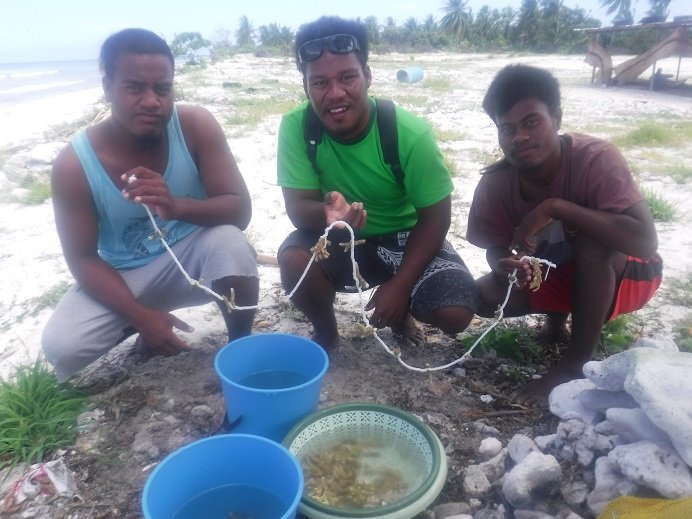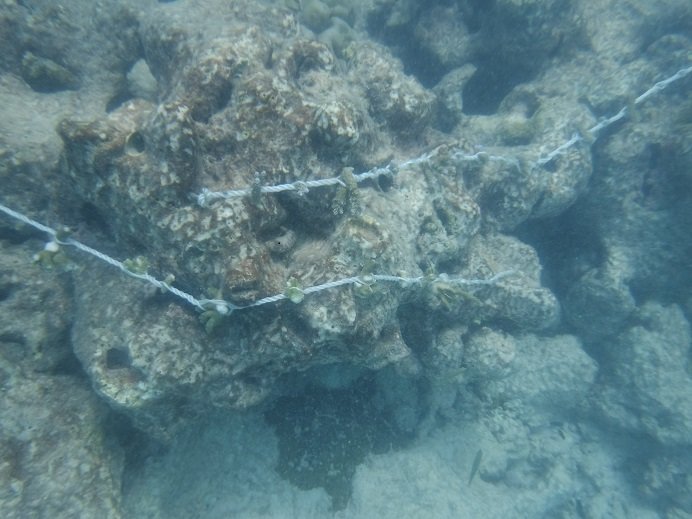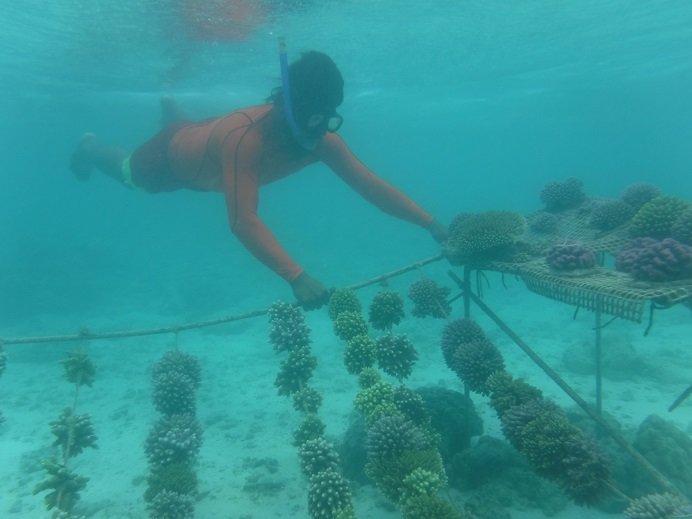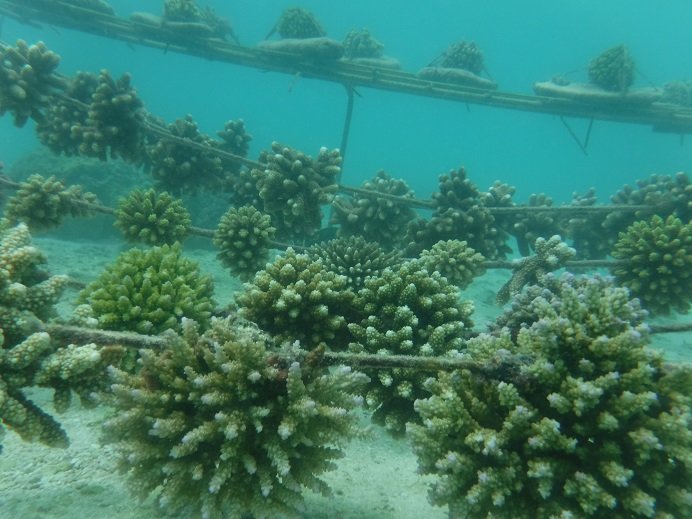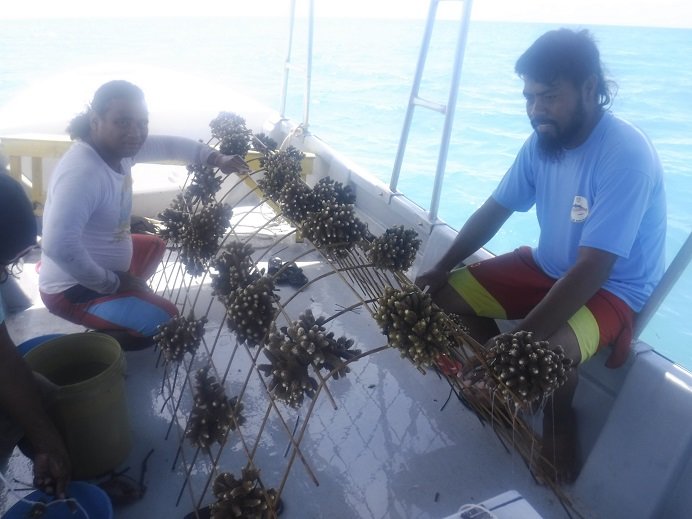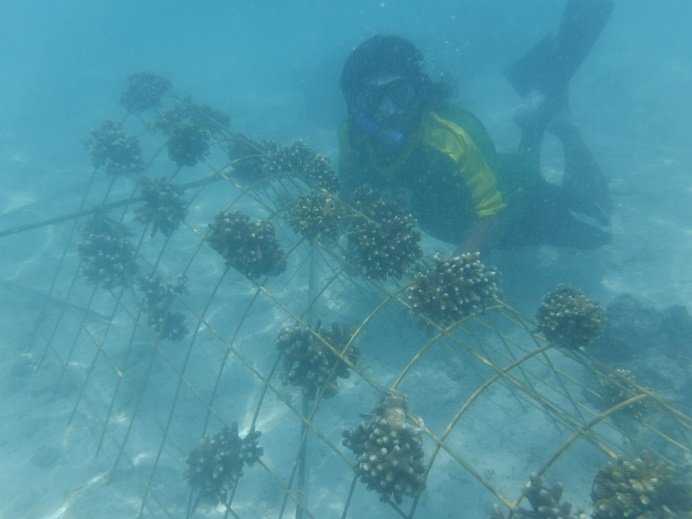By Austin Bowden-Kerby | Project Scientist, and defender of the corals
In spite of a spreading pandemic, I was able to travel to Christmas Island Kiribati with our C4C board member Simi Koto in early March. While I focused on the coral nurseries, Koto focused on land-based livelihoods and agricultural self sufficiency as we work with communities to increase prosperity through better managment of natural resources and nature, including proposed no-fishing areas to help restore the coral reefs.
The coral reefs of Christmas Atoll experienced extremely hot water and an associated mass coral bleaching event that lasted for 14 months in 2015-2016, and that killed 95% of all corals and >>99% of branching corals. The reefs are now dominated by dead coral rock, and a toxic microalgae has covered the rocks, working its way into the food chain, so that most reef fish have now become too poisonous to eat. This fish flesh toxin is called "ciguatera", and it can be deadly or debilitating. I ate reef fish on the atoll only once back in November, and became extremely ill. Taratau Kirata, the head of Fisheries, our major partner on the island, providing assistance with boats etc, was hospitalized last year from severe ciguatera poisoning, as have increasing numbers on the island. Many people have learned to avoid the problem by eating milkfish and deep ocean fish like Tuna, which are safe, however, an entire island community is at risk, and food security has certainly been compromised. The long-term solution to this problem is to work to get corals back as the dominant species on the coral reefs of Christmas Island, and this is our long-term goal, working in partnership with mother nature, the island communities, and government.
While it is impossible to replant the whole reef, it is possible to help re-boot and enhance natural recovery processes. I will attach a document that has our Pacific-wide strategy, for any who might want more scientific information. The strategy works to create small patches of "super corals" by planting small second generation branches trimmed from the nursery, Within two years the corals grow to adult size and will begin spawning to produce coral larvae, sending them out into the water. The coral patches in theory also serve as a strong settlement signal to any incoming coral larvae, and it has been proven that they share their resistant micro algae with the newcomers, spreading their resistance to future bleaching events.
Our blaching resistant "super corals" have grown big within the coral nursery and we are at the stage where we must trim the mother corals and use the resulting branches to replant patches of corals back onto the reef. Indeed the corals are becoming crowded, and trimming them also helps avoid competition in the nursery. Each of the small 3-10cm coral fragments that result from this trimming are woven into the strands of thin ropes to creat a lei of corals, and then the lei is nailed to the dead reef, where each coral fragment grows, self-attach, and flourish on the reef. We have replanted one coral patch on the reef where the corals are now adult-sized, and additional new patches were replanted in March at two sites. Parrotfish bites are the worse problem we are facing, and so we are focusing on outplanting to increase the corals around the nursery, so that the parrotfish will have more corals to chew on - and so that hopefully there will be relatively less damage to each coral colony. In addition to five Fisheries staff, six youth volunteers joined us in the work, and so the sessions became local capacity building sessions, creating positive vision for the future.
Thanks to GlobalGiving, I have been able to return to the island twice per year since 2016, for a total of nine trips of 1-3 weeks each, accomplishing quite a lot. The airplane only comes once a week- or it did until the pandemic began. We were on the very last plane to leave the island in mid March, and flights have not yet resumed. Others who stayed behind are still waiting. As Kiribati has not has a single case of COVID-19, and as Fiji has had no community spread of the virus for over four months, there is talk of re-opening flights, so we look forward to returning soon.
On returning, we are planning to upscale the work, focusing on more shallow reef sites acessible from shore, and involving more youth from each of the four villages of the island in the coral work, building understanding of coral reefs, the impacts of climate change, and the importance of the work on Christmas Island, as these humble efforts are now part of the leading edge of combatting the extinction of coral reefs globally.
Thanks again for your support and interest in this vital work.
Project reports on GlobalGiving are posted directly to globalgiving.org by Project Leaders as they are completed, generally every 3-4 months. To protect the integrity of these documents, GlobalGiving does not alter them; therefore you may find some language or formatting issues.
If you donate to this project or have donated to this project, you can receive an email when this project posts a report. You can also subscribe for reports without donating.
Support this important cause by creating a personalized fundraising page.
Start a Fundraiser